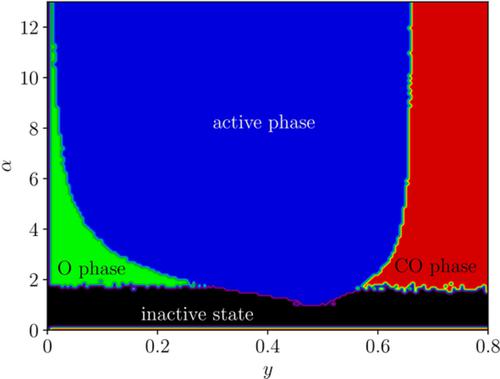当前位置:
X-MOL 学术
›
J. Comput. Chem.
›
论文详情
Our official English website, www.x-mol.net, welcomes your
feedback! (Note: you will need to create a separate account there.)
Phase diagrams of the Ziff–Gulari–Barshad model on random networks
Journal of Computational Chemistry ( IF 3.4 ) Pub Date : 2020-06-29 , DOI: 10.1002/jcc.26366 Edda B Vilela 1 , Henrique A Fernandes 1 , Fábio L Paranhos Costa 1 , Paulo F Gomes 1
Journal of Computational Chemistry ( IF 3.4 ) Pub Date : 2020-06-29 , DOI: 10.1002/jcc.26366 Edda B Vilela 1 , Henrique A Fernandes 1 , Fábio L Paranhos Costa 1 , Paulo F Gomes 1
Affiliation

|
In this study, we revisited the Ziff–Gulari–Barshad (ZGB) model in order to study the behavior of its phase diagram when two well‐known random networks play the role of the catalytic surfaces: the random geometric graph and the Erdös–Rényi network. The connectivity and, therefore, the average number of neighbors of the nodes of these networks can vary according to their control parameters, the neighborhood radius α, and the linking probability p, respectively. In addition, the catalytic reactions of the ZGB model are governed by the parameter y, the adsorption rate of carbon monoxide molecules on the catalytic surface. So, to study the phase diagrams of the model on both random networks, we carried out extensive steady‐state Monte Carlo simulations in the space parameters (y, α) and (y, p) and showed that the continuous phase transition is greatly affected by the topological features of the networks while the discontinuous one remains present in the diagram throughout the interval of study.
中文翻译:

Ziff-Gulari-Barshad 模型在随机网络上的相图
在这项研究中,我们重新审视了 Ziff-Gulari-Barshad (ZGB) 模型,以研究当两个众所周知的随机网络扮演催化表面的角色时其相图的行为:随机几何图和 Erdös-Rényi网络。因此,这些网络的节点的连通性和平均邻居数可以分别根据它们的控制参数、邻域半径 α 和链接概率 p 变化。此外,ZGB 模型的催化反应受参数 y 控制,即一氧化碳分子在催化表面的吸附率。因此,为了研究模型在两个随机网络上的相图,我们在空间参数 (y, α) 和 (y,
更新日期:2020-06-29
中文翻译:

Ziff-Gulari-Barshad 模型在随机网络上的相图
在这项研究中,我们重新审视了 Ziff-Gulari-Barshad (ZGB) 模型,以研究当两个众所周知的随机网络扮演催化表面的角色时其相图的行为:随机几何图和 Erdös-Rényi网络。因此,这些网络的节点的连通性和平均邻居数可以分别根据它们的控制参数、邻域半径 α 和链接概率 p 变化。此外,ZGB 模型的催化反应受参数 y 控制,即一氧化碳分子在催化表面的吸附率。因此,为了研究模型在两个随机网络上的相图,我们在空间参数 (y, α) 和 (y,











































 京公网安备 11010802027423号
京公网安备 11010802027423号